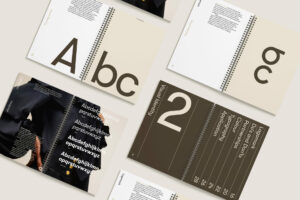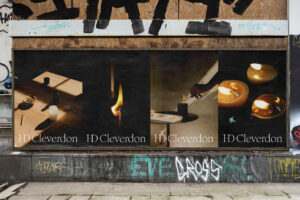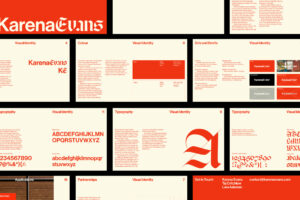What is a visual identity, why should you have one, and how do you make one? Questions humanity has pondered since the dawn of time (maybe).
Well, good news. We’re about to answer these questions once and for all in the next 5 minutes of reading. But first, to properly answer them, we need to set something straight.
A visual identity is not a brand.
People often use the words ‘brand’ and ‘visual identity’ (or ‘brand identity’) to mean the same thing, but they aren’t.
A visual identity is just part of a brand. A crucial part no doubt, but it’s just one of the building blocks.
So to properly explain visual identity, we first need to look into what a brand is to understand the role that a visual identity plays.
What is a brand?
A brand is simply how people perceive a business or organisation (or even an individual). Not just in a marketing sense, but in a total sense.
It’s what people think and feel when they see a business, and it’s influenced by every experience people have with it. From marketing, to recruitment, to customer support, to events, to retail, to working culture, every action taken by a company is connected back to the brand and contributes to it.
But a brand is not made overnight, nor is it conjured into existence with a logo. A brand is an experience that is fostered, then carefully and consistently applied throughout a business, and maintained both internally and externally.
By building a brand, a company can put itself in control of how it is perceived and can shape the story being told about it.
And how do you shape a brand? This is where visual identity comes in. A big part of shaping a brand image is about establishing how a company looks when it communicates.
Which is decided by, you guessed it, a visual identity.
What is a visual identity/brand identity?
So, we know that a brand is much more than what you see in adverts. It’s what people think and feel of a company in a broader sense.
The way a company looks in adverts, then, comes from defining the brand’s visual identity. This identity is the visual representation of a brand experience and is made up of a logo, colour palette, and choice of typeface(s). And so visual identity and graphic design very much go hand-in-hand.
Now, there is often a misconception that a logo is the end all and be all of a ‘brand’, but this is not the case. This logo needs to exist in a complete visual system designed to support and complement it.
By defining all of these visual elements, it lays a foundation for every piece of communication and graphic design that comes from a business, bringing vital consistency every time that business speaks and distinguishing it from everyone else.

See more of our visual identity examples.
This consistency is a really significant part of establishing a brand image. By always looking and feeling the same, it creates a single unified persona that people start to connect with, get to know, and trust.
So this all sounds wonderful, but what’s the point of a visual identity? What value does it actually bring?
Let’s jump in.
Why a brand visual identity is so important
Doing branding properly, and creating a thoughtful visual identity, brings incredible advantages. It isn’t just a case of looking nicer, it completely changes what people think of a company.
We could write for a long time on the benefits here, but we’ll resist that temptation and try to summarise the main points in short(ish) bullet points:
Better perception
- A well-made brand identity changes how people perceive a company for the better. Thoughtful, considered branding adds credibility, legitimacy, and trustworthiness to a business because it shows that the company cares about how it comes across.
- A visual identity can also help to make the best possible first impression. People make many assumptions about a business based on appearance alone, and the more effort put into presentation, the better the assumptions people will make.
More memorable
- Clear and consistent communication allows every piece of marketing to be recognisable, and this helps people to remember a company.
- Consistency brings clarity to what a business offers people, with inconsistency bringing confusion that puts people off from wanting to engage.
Deeper connections
- Visual consistency also facilitates better relationships with audiences. By creating a single, unified identity, customers will start to feel like they know a brand. It’s easier for people to have a connection with that brand because there is a single ‘personality’ for them to build a relationship with.
- Such relationships also drive customer loyalty. Once you establish these relationships, people trust you, listen to you, and keep coming back for more.

So, investing in branding is crucial to long-term growth. It gets people interested, and helps to build loyalty and connection over time.
Great news. But how do you make a good visual identity?
How to make a great visual identity (graphic design skill needed)
As we alluded to earlier, a brand identity is not just a logo. It’s a visual system that includes a logo, colour palette, and typeface choices.
This holy trinity of visual elements needs to be carefully and cohesively designed, but how is that done?
Well, any good brand identity visualises a brand experience. It takes what a company holds true, and communicates it to the world. So the ideal starting point is getting a proper understanding of a company by asking the right questions.
Questions like this:
- What is the purpose of this business/organisation? Why does it exist?
- What’s the story behind how they got here?
- What does the target market of this brand care about? What matters to them?
- What is the culture around this brand and its people?
- What makes this company unique?
These kinds of questions give valuable inspiration to form a creative direction and help to shape the visual story we are going to tell. This paves the way for a thoughtful, meaningful, and substantive brand identity.
Defining this visual story also gives a common background behind each part of the identity, making sure everything is nice and cohesive.
So at this point, it goes without saying that a visual identity shouldn’t be randomly assembled, or put together based on subjective personal preferences (e.g. “the boss loves the colour red”). Instead, it needs to be anchored in real world associations to achieve depth, substance, and resonance.

There must be a purpose behind every choice, with no part of a brand identity chosen simply because it ‘looks nice’ or ‘feels good’.
And once the visual identity is created, explaining it in a brand guideline is the final step to ensuring that it’s always used consistently and correctly. This then enables a company to shape a recognisable brand image that people know and understand.
You can read more about how we help companies do this here.
The end
So, that’s a visual identity. While it certainly doesn’t make a whole brand, it’s a huge part of shaping it.
Done right, with careful consideration given to culture, values, story, and vision, a visual identity can make a business more credible, more memorable, and easier to connect with. Taking this brand experience throughout every part of an organisation is then how a brand truly defines how it is perceived (marketing strategy is also very influential in building that perception).
So, that’s visual identity. That’s brand. We thank you very much for reading, and fingers crossed you’ve learned something useful today.
We hope you come back for more articles from Fook, and if you have any questions, feel free to use the form below to ask away.